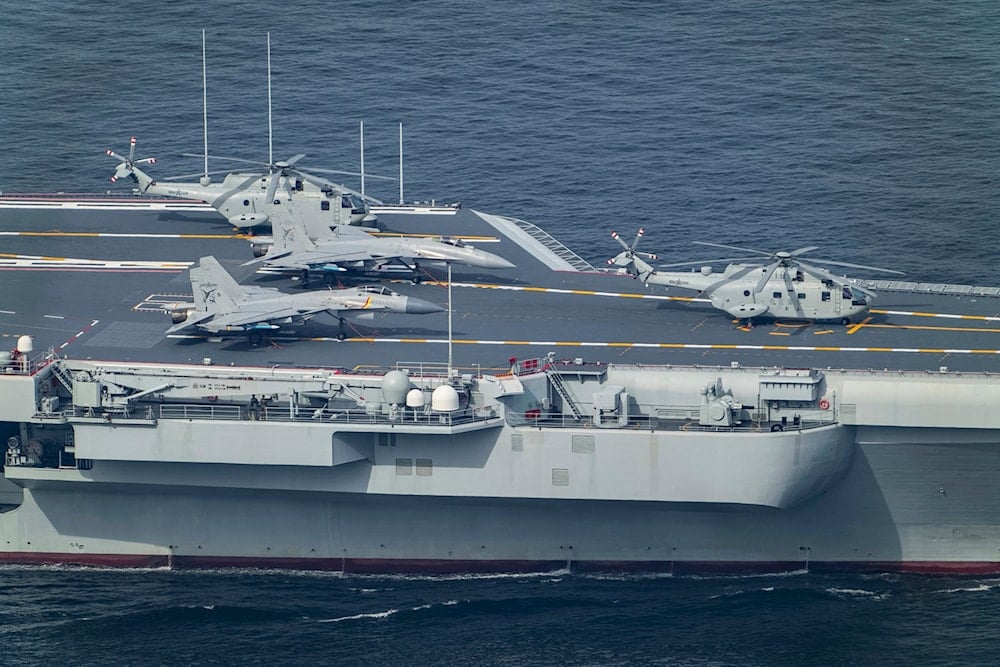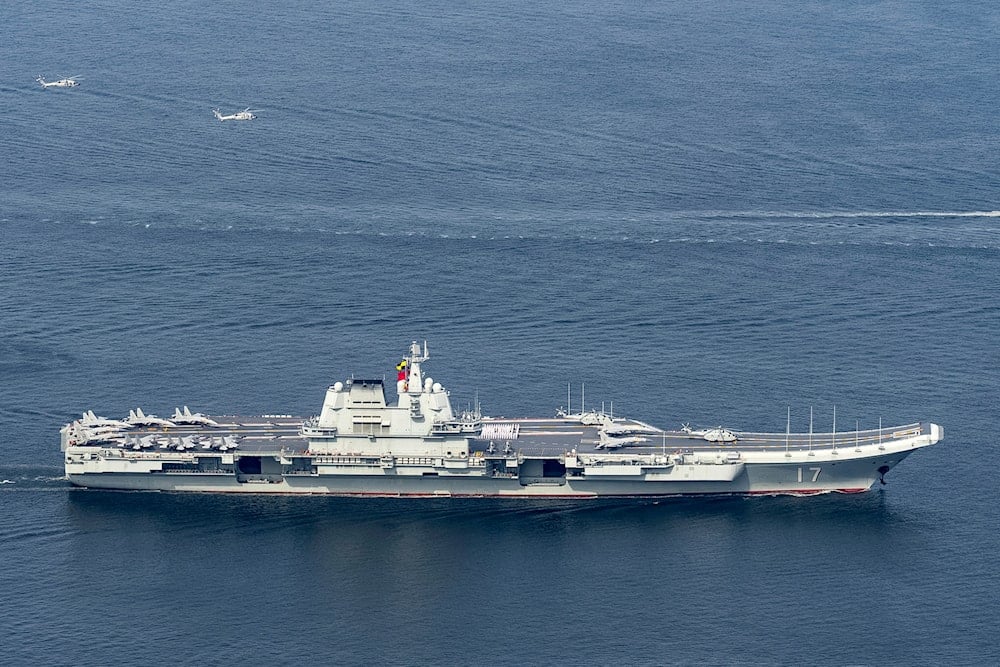China commissions Fujian: EMALS carrier sharpens Beijing’s naval reach
Read our in-depth analysis of China’s newly commissioned Fujian aircraft carrier and the technological leap that expands the PLAN’s operational reach.
-

China's President Xi Jingping, center, poses for a photo with the crewmembers of the Type-003 Fujian aircraft carrier, during a commissioning ceremony in Sanya, Hainan, on November 7, 2025 (X/@ChinaMilBugle)
China formally commissioned its third aircraft carrier, the Type-003 Fujian, on Wednesday, after a ceremony in Sanya, Hainan, attended by President Xi Jinping, China's Xinhua news agency said on Friday.
The ship, the first carrier wholly designed and built in China with a flat flight deck and electromagnetic aircraft launch system (EMALS), completes a long sea-trial program in which the navy demonstrated catapult launches and arrested recoveries of carrier-based types.
The commissioning marks a visible milestone in the People's Liberation Army Navy’s (PLAN) drive to field a credible blue-water carrier force.
Why the EMALS matters
"After the ceremony, Xi Jinping boarded the Fujian, and learned about the development of the aircraft carrier system combat capabilities and the construction and application of the electromagnetic catapult system," Xinhua wrote.
Xinhua said Xi "personally decided" that the Fujian would adopt an EMALS system.
EMALS replaces ski-jump launches and steam catapults with electromagnetic catapults that accelerate aircraft along a precisely controlled track. Practically, that means the Fujian can launch heavier airframes. This includes fully loaded fighters, airborne early-warning aircraft, and future unmanned wingmen with less stress on airframes and potentially higher sortie rates.
In turn, this translates to longer-range strike packages, larger organic airborne early-warning (AEW) coverage, and the capacity to field more advanced avionics and weapons from the carrier deck. In this sense, organic AEW is the ability of a carrier to field its own early-warning aircraft rather than assets based ashore or provided by other ships or allies.
Earlier in September, Chinese technical assessments and footage released during trials show successful EMALS launches of the J-35, J-15T, and the KJ-600, asserting Beijing’s claim of a functional Catapult Assisted Take-Off But Arrested Recovery (CATOBAR) carrier architecture.
China’s first two carriers, Liaoning and Shandong, rely on ski-jump ramps (STOBAR systems), which restrict launch weight and aircraft types.
-

Two Z-18J naval airborne early warning helicopters are stowed on the People's Liberation Army Navy's Shandong aircraft carrier, as it sails into Hong Kong, China, for a port call, on July 3, 2025. These are the AEW aircraft that China's carriers were capable of organically deploying prior to the commissioning of the Fujian. (AP)
For PLAN, the shift from STOBAR to CATOBAR represents a generational leap, transforming the carrier into a true power-projection tool. It means that, for the first time, China can field carrier-based early-warning and control aircraft comparable to the US Navy’s E-2 Hawkeye, giving each strike group a real-time radar and command umbrella extending hundreds of kilometers beyond the fleet.
While the United States currently operates only one EMALS-equipped carrier, the USS Gerald R. Ford, the Fujian now places China among the only two navies worldwide with such technology in active service. The change also fundamentally upgrades the PLAN’s operational playbook; China can now sustain complex, long-range air operations from the sea, giving it a cornerstone of regional deterrence and deep-sea reach.
-

China's first domestically built aircraft carrier, Shandong, sails into Hong Kong for a port call, on July 3, 2025. The inclined ramp of the Shandong's STOBAR architecture can be seen on the right end of the carrier. (AP)
The carrier air wing; J-35, J-15T, KJ-600 and more
The combat punch of any carrier is its air wing. Public reporting and PLAN material suggest the Fujian will operate a mixed air group that includes the navalized J-35 stealth fighter, upgraded J-15T multirole fighters, and the KJ-600 early-warning platform, alongside helicopters and, over time, carrier-capable unmanned systems.
The J-35’s integration with EMALS is particularly consequential, as it offers a stealthy, carrier-borne fighter able to be launched fully laden, expanding the PLAN’s air superiority, strike capabilities, and suppression of enemy air defences in contested littoral zones.
Breakthrough: #Photos show #J15T heavy fighter jet, #J35 stealth fighter jet, and #KJ600 EWA completing their first electromagnetic catapult-assisted takeoff and arrested landing training on China's first electromagnetic catapult-equipped aircraft carrier #Fujian (Hull 18).… pic.twitter.com/8mkqIbVuua
— China Military Bugle (@ChinaMilBugle) September 22, 2025
A J-35 armed with PL-15 beyond range of vision (BVR) air-to-air missiles operating from the Fujian offers the PLAN a critical asset.
The PL-15 provides stand-off engagement capability against aircraft and high-value support assets, and the carrier’s EMALS-enabled sorties, cued by organic KJ-600 AEW, create a sensor-shooter loop that can detect, track, and prosecute targets well beyond the visual horizon. Together, they allow the PLAN to conduct sustained air-dominance and suppression missions from the sea, threaten allied AEW/tanker platforms that previously enjoyed sanctuary, and push the effective engagement envelope outward across the South China Sea. This raises the cost and complexity of any opposing air or maritime operations.
What this means for US naval dominance
Despite these critical developments, the US retains structural advantages, nuclear propulsion for sustained high-speed transit, global basing, a larger fleet of carriers, integrated logistics, and decades of carrier strike group operational experience.
Washington’s immediate responses will likely mix public diplomacy and concrete measures, including increased maritime support for allies, stepped-up joint patrols with partners, and offers of capability sharing to shore up deterrence.
US officials have already signalled intent to bolster alliance cooperation and to monitor China’s expanding power. At the same time, recent high-profile US carrier aviation mishaps, two aircraft from USS Nimitz went into the sea in late October during South China Sea operations, will be pressed into the political narrative about readiness, even if they do not alter force structure.
Read more: Red Sea rising: Exposing the West's diminishing naval power
Operational limitations, vulnerabilities
Moreover, for any navy in the world, commissioning is not the same as combat readiness.
EMALS and new airframes reduce some technical constraints, but carrier operations remain among the most demanding in modern militaries. The PLAN must develop high-tempo deck cycles, carrier-strike group integration, destroyers, frigates, submarines, logistics, and sustainment pathways for long deployments.
The Fujian will also face asymmetric threats that complicate its freedom of maneuver, long-range anti-ship missiles, advanced submarines, maritime mines, and layered air-defense networks. Moreover, without a comparable network of overseas bases, China’s ability to sustain carrier operations far from home will rely on at-sea replenishment and diplomatic access.
Production tempo, readiness, and what to watch next
China’s shipbuilding pace and the public visibility of EMALS trials suggest Beijing intends the Fujian as a platform from which to iterate quickly. More Type-003 variants, follow-on classes, and possibly nuclear-powered carriers will be seen in the long term. Key metrics to watch are the carrier’s operational deployment patterns, the frequency and complexity of multicarrier exercises, J-35 sortie rates and AEW coverage, and how quickly the PLAN establishes sustainable carrier strike groups with integrated logistics.
Equally important will be Washington’s alliance responses, enhanced patrols, technology sharing, and combined training, which will shape the strategic balance across the Indo-Pacific.
The Fujian changes the chessboard; how players reposition their pieces will determine the durable shift in regional naval dynamics.
Read more: Trump’s nuclear claims: Misreading strategy as Russia, China modernize

 6 Min Read
6 Min Read










